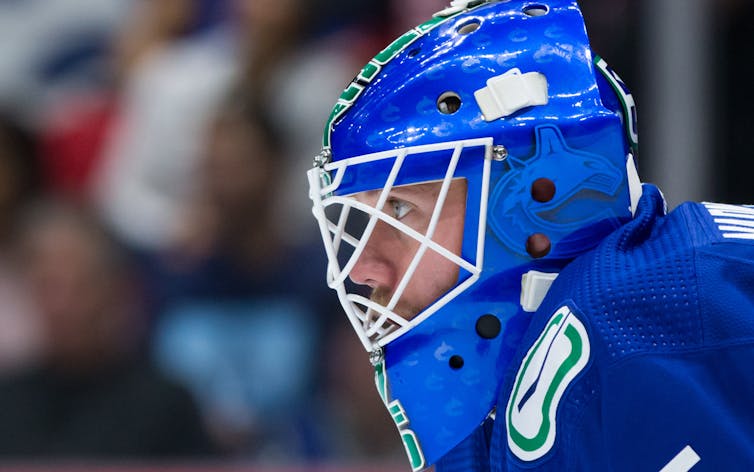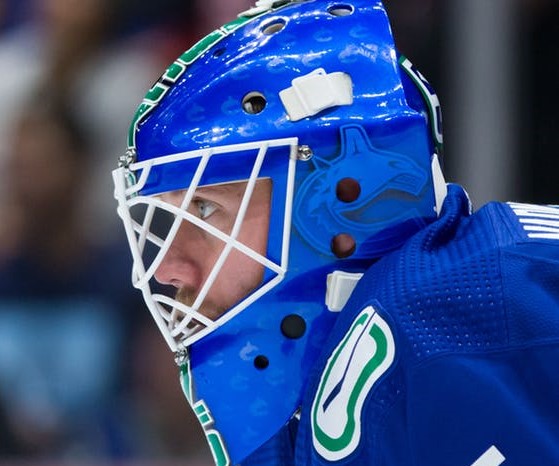
Vancouver Canucks goalie Jacob Markstrom, of Sweden, looks on during the first period of an NHL hockey game against the Carolina Hurricanes in Vancouver, on Dec. 12, 2019. THE CANADIAN PRESS/Darryl Dyck Taylor McKee, Western University and Janice Forsyth, Western University
Allegations about harassment, abuse and discrimination in hockey have rocked the sport over the past few weeks. Yet there is a curious silence as to how Sport Canada’s new suite of “safe sport” policies can help clean up the mess.
In late June 2019, the federal government announced its commitment to making sport “safe, welcoming and inclusive.” They backed up that commitment with a $30 million investment over five years. Sport Canada’s safe sport initiative allows “Canadian sport organizations to ensure a safe and healthy sport environment by supporting additional measures to eliminate abuse, discrimination, harassment and maltreatment in sport.”
If there are mechanisms in place to help address hockey’s toxic culture — including initiating an independent third-party investigation — then shouldn’t we be talking about how to put these policies into effect and how to improve their effectiveness?
Signs of a troubled hockey culture
Commonly thought of as the connective tissue bonding Canadians, claims of abuse, discrimination and harassment have revealed hockey as a blunt instrument that tears this connective tissue apart.
When the highly successful, historic and Indigenous-led Beardy’s hockey program was phased out of the Saskatchewan landscape, Indigenous and non-Indigenous players were denied valuable opportunities to interact and participate in intercultural exchange through sport.
Read more: Bring back Beardy's Blackhawks: Indigenous hockey team eliminated from Sask. league
When former Calgary Flames head coach Bill Peters, then a coach for the Rockford Ice Hogs of the American Hockey League, used the N-word when dealing with a Black player, he did so because his career has existed within a racially homogenized, insulated environment. Peters was once recognized as one of Hockey Canada’s preferred coaches at the international level, coaching the Canadian under-18s, the World Championships and an assistant coach at the 2016 World Cup of Hockey. This culture sheltered him from the consequences of using hateful language.
And, following years of making xenophobic comments during the Coach’s Corner segment of Hockey Night in Canada, longtime hockey commentator Don Cherry insinuated in a pre-Remembrance Day broadcast that immigrants were not grateful for the sacrifices of Canadian veterans.
These recent incidents are a part of hockey culture. They defy the safe, welcoming and inclusive space needed for athletes, coaches and other participants to excel. The implementation of the safe sport policies is crucial as hockey is reaching a crisis point regarding the abuse of players. These policies could be the impetus needed to force hockey and coaching organizations to face the issue head on.
More oversight in sports
It’s easy to focus on coaches as individuals. They serve as the de facto child and youth care workers, teachers and caregivers all rolled into one. Still, we cannot blame coaches any more than teachers should be the only ones held accountable for unethical classroom conduct. There needs to be oversight of what coaches do. Sports, and not just hockey, has been left to police itself for too long. Should those leaders turn a blind eye, then they should be held accountable for condoning such behaviour.
The need for oversight in organized sport has never been more apparent, especially in the wake of numerous scandals in the NCAA. Consider Penn State and Michigan State’s sexual abuse scandals.
Certainly the new safe sport policies for Canada have yet to be tested and, indeed, have some serious imperfections to work out. Thankfully, there are indications from government that its intent is genuine. For example, it may withhold funding if a sport organization does not implement “specific measures” to ensure compliance with the policies.
Still, other indicators are cause for concern. The independent third-party investigation option is available as a pilot project and closes March 2020. Can enough reliable evidence be collected in less than one year about these complex issues?
Troublingly, the safe sport policies deal almost exclusively with accountability measures for catching offenders. There is almost no emphasis on helping victims come forward and heal their wounds in a safe and respectful environment.
The disregard for their health and safety is similar to the lack of supports proposed for professional hockey players. In the wake of the Peters and Cherry scandals, the NHL recently instituted a “mandatory annual program on counselling, consciousness raising, education and training on diversity and inclusion for head coaches and general managers.” Similar to the safe sport policies in Canada, there appears to be no support for the victims, in this case, the professional players.
Certainly, harassment, abuse and discrimination in hockey are not exclusively the NHL’s problem. The Graham James abuse scandal from within Canadian junior hockey serves as a chilling reminder of the vulnerability of minors in Canada’s hockey system. As the world’s largest and most lucrative hockey organization, the NHL could require its affiliates to adopt safe sport policies similar to those being enforced in Canada.
Can hockey afford to clean up its mess?
The $30 million over five years might seem like a significant investment by the federal government. Yet this only amounts to $6 million per year to reform the entire Canadian sport system. Given the magnitude and depth of harassment, abuse and discrimination in hockey alone — from the grassroots to the professional level — addressing this issue using the courts could hamstring the budgets of many organizations.
The NHL generated US$5.09 billion in revenue during the 2018/19 year. If the NHL decided to finance the implementation of the safe sport policies for hockey, it would account for 0.12 per cent of their 2018/19 revenue.
It might not be feasible to expect the NHL to cover these financial costs entirely. However, the NHL will continue to incur tangible and intangible costs by allowing players to remain vulnerable.
The cost of safe sport extends far beyond a balance sheet.
[ You’re smart and curious about the world. So are The Conversation’s authors and editors. You can read us daily by subscribing to our newsletter. ]
![]()
Taylor McKee, PhD Candidate and Instructor, Faculty of Health Sciences, Western University and Janice Forsyth, Associate Professor, Sociology & Director, Indigenous Studies, Western University
This article is republished from The Conversation under a Creative Commons license. Read the original article.
"Voices of the RSC” is a series of written interventions from Members of the Royal Society of Canada. The articles provide timely looks at matters of importance to Canadians, expressed by the emerging generation of Canada’s academic leadership. Opinions presented are those of the author(s), and do not necessarily reflect the views of the Royal Society of Canada


